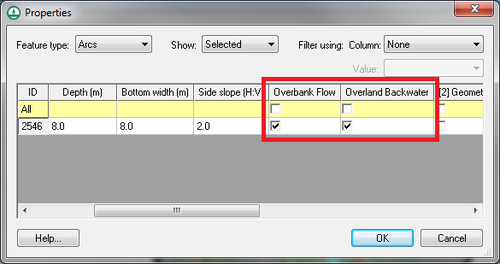WMS:GSSHA Feature Arcs: Difference between revisions
No edit summary |
No edit summary |
||
| Line 72: | Line 72: | ||
[[Category:GSSHA|F]] | [[Category:GSSHA|F]] | ||
[[Category:WMS Feature Objects| | [[Category:WMS Feature Objects|GSSHA]] | ||
[[Category:GSSHA Dialogs|Feat]] | [[Category:GSSHA Dialogs|Feat]] | ||
Revision as of 15:34, 31 January 2017
The Coverage Properties dialog is where the attributes associated with feature arcs on the GSSHA coverage are defined. This dialog is accessed either by double-clicking on a feature arc or by selecting the Feature Objects | Attributes... menu command in the Map Module. It is possible to change the feature type attributes that are displayed in the table, select whether to show attributes for all features or just the selected features, and to filter the data shown in the table based on specific attribute values.
GSSHA Arc Types
Generic
Generic arcs have no attributes and are typically used when constructing polygons.
Parameters: None
General Stream
General stream arcs are identical to streams defined for drainage coverages and are used when going back and forth between coverage types. General stream arcs are not used to generate input for GSSHA simulations.
Parameters: None
Trapezoidal Channel
Trapezoidal cross-sections are used to define channel routing in GSSHA models. WMS automatically assigns a link number to trapezoidal channel arcs. By default the geometric parameters of the trapezoidal channel are applied to the entire channel (link), although it is possible to assign both upstream and downstream geometric parameters for the channel (link) by toggling on the [2] Geometry option. GSSHA will interpolate a cross section at each node in the link using the upstream and downstream channel geometries.
Parameters: Manning’s n value, channel depth, bottom width, and side slope Other: Enter the maximum depth of channel erosion if the soil erosion option is turned on in the Job Control
Cross Section Channel
The profile of irregular cross sections are defined using X, Y coordinate pairs. GSSHA computes conveyance parameters including area, top width, and conveyance at incremental depths of flow up to the maximum depth specified in the Max conveyance depth column of the table.
Parameters: Manning's n value, cross section profile, and maximum conveyance depth Other: Enter the maximum depth of channel erosion if the soil erosion option is turned on in the Job Control
Embankment
Embankments represent overland flow hydraulic structures such as levees or roads. They modify flow by either preventing flow between adjacent cells or acting as a weir if the flow reaches above the crest elevation of the embankment.
Parameters: embankment profile
See GSSHA Embankment Arcs for more information.
Pipe
Pipe arcs are used to conceptualize sub-surface storm/tile drain systems. Looped configurations are allowed.
Parameters: type (circular or rectangular), geometric properties, slope, Manning's n value, length, conductance (tile drains only), and superlink number
Sub-surface Losses/Gains
If the Groundwater (sub-surface) option in the GSSHA Job Control is turned on then it is possible to toggle on the option to compute sub-surface losses/gains by entering sediment thickness and hydraulic conductvity.
Groundwater BC
Assign one of the following groundwater boundary conditions to the 2D grid cells intersecting the feature arc: Generic, No Flow, Constant Head, Flux River, or Head River. For more information, see GSSHA Groundwater.
Solution Results
Click on the button to view results at all node locations for the link in the stream/channel network. See GSSHA Solution Results for information.
Specified Overbank and Backwater Channel Links
GSSHA has two options that could be defined globally. The first option, the overbank flow option (OVERBANK_FLOW), increases the level of connection between the overland flow and the channel in the 1D hydraulic model by allowing water to spill from the channel back onto the overland flow plane. If the second option, the overland backwater option (OVERLAND_BACKWATER), is turned on, flow from the overland flow model to the channel in the 1D hydraulic model is restricted if the elevation of the water in the channel exceeds the overland cell elevation. This option can be defined at each of the arcs (links) in the GSSHA model in the GSSHA arc properties dialog. If this option is defined for one of the arcs, the global option is turned off.
Related Topics
- GSSHA Embankment Arcs
- GSSHA Feature Nodes
- GSSHA Feature Polygons
- GSSHA Groundwater
- GSSHA Job Control
- GSSHA Solution Results
- GSSHA Stream Arcs
| [hide] GSSHA | |
|---|---|
| XMS Wiki Links | Calibration (Automated • Manual • Output) • Channel Routing • Contaminants • Digital Dams • Embankment Arcs • Feature Objects (Arcs • Nodes • Polygons) • File Types • Groundwater • Groups • Hydraulic Structures • Job Control • Join SSURGO Data • Mapping Tables • Maps • Menu • Model Linkage • Multiple Simulations • Nutrients • Observations • Output Control • Overland Soil Erosion • Pipe and Node Parameters • Precipitation • Radar Rainfall • Save GSSHA Project File • Smooth GSSHA Streams • Snowmelt • Solution (Analysis • Data) |
| Related Tools | MWBM Wizard • Using Soil Type Data with GSSHA |
| GSSHA Wiki External Links | GSSHA Wiki: Overview • Primer • User's Manual • Tutorials |

